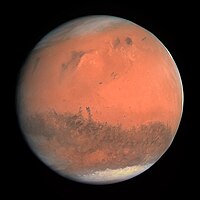
Photo from wikipedia
The tidal response of Mars, due to the Sun and the Martian moons, Phobos and Deimos, provides information about the interior structure of Mars. By using the Very Broad Band… Click to show full abstract
The tidal response of Mars, due to the Sun and the Martian moons, Phobos and Deimos, provides information about the interior structure of Mars. By using the Very Broad Band (VBB) seismometer of Seismic Experiment for Interior Structure (SEIS) as a gravimeter on the surface of Mars, the InSight mission will provide the long‐period data suited to tidal analysis: most notably, the proximity of Phobos implies that degree 2, 3, 4, and further tides will be detectable by the VBB and are expected to provide information about the rheology at different depths within Mars. In order to expedite the recovery of these tidal signals in the SEIS measurements, we model the tides raised by Phobos using a tidal potential deduced from JPL Horizons ephemerides. From this potential, we calculate the expected tidal acceleration at InSight's location and gravimetric factors using a set of plausible interior models of Mars. To simulate the expected long period signal on the VBB seismometer, we use the InSight Auxiliary Payload Sensor Suite data to model the noise seen at low frequency by SEIS mainly due to temperature and pressure variations. Based on this synthetic signal, by applying filtering methods such as stacking and matched filtering to these synthetic data, we show that by recovering the gravimetric factors, it should be possible to constrain the state of the core and its size with an accuracy of 125 km after two Earth years.
Journal Title: Earth and Space Science
Year Published: 2021
Link to full text (if available)
Share on Social Media: Sign Up to like & get
recommendations!